Abstract
This paper considers mineral compositions and prospects for the processing of natural blue montmorillonite clay, pink Fe (III)-containing clay, and green Fe (II)-containing clay into composite aluminosilicate materials suitable for the sorption of related substances of vegetable oils. New Brønsted and Lewis centers were found on the surface of the materials obtained when solutions of oxalic and succinic acids and sodium carbonate in scientifically-substantiated amounts were used as modifying additives. The established changes in the surface states are in correlation with the assessed affinity degree of active sites towards fatty acids, peroxide compounds, carotenoids, and chlorophylls in vegetable oils (flaxseed, olive, mustard), which are rarely refined in world production. These findings are of practical value for the development of a new direction of medical chemistry. It was revealed that the presence of impure hydromuscovite in natural raw materials and the resulting materials reduces the effect of extracting dyes from vegetable oils.
1. Introduction
Studies on the optimization of the process of sorption extraction of impurity substances of vegetable oils are very topical. Natural aluminosilicates are now widely used as binders, granulators, and sorbents for the purification of aqueous media [1,2] and fatty media [3,4,5]. In particular, aluminosilicates are widely used for the clarification of vegetable oils, i.e., for isolation of the pigment complex components (carotenoids and chlorophylls) during refining [6]. The requirements of the aluminosilicates include: good adsorption capacity; to have sufficient number of active centers; be easily separated during filtration; not affecting the taste characteristics of the oil [7]. The chemical composition of aluminosilicate sorbents is specified by the peculiarities of the processes occurring in rocks and the earth’s crust.
Among the aluminosilicates, the montmorillonite mineral is the most widespread in the nature. The properties of montmorillonite have been adequately studied [8]. Its crystal lattice provides the possibility of introducing fragments of organic substances [9]. This reveals the prospects for the creation of hybrid organic–inorganic composites with a complex of unique physical and chemical properties.
Another common compound in the composition of natural mineral sorbents is kaolin, which is well dispersed in various media [10,11,12]. The particle size distribution is the most important characteristic of kaolin. The improved physical, mechanical, and sorption properties are achieved when using medium-dispersed kaolin with low oil absorption [13]. It is also known [14,15] that kaolin, in combination with calcium carbonate, is used to obtain high-quality primers. Driven by the search for suitable media for electrophoresis, the world demand for finely dispersed kaolin with the addition of water-soluble salts has increased.
When polymineral natural raw materials containing lamellar mica (potassium aluminosilicate, in mineralogy—muscovite) with K2O content ≥10% are processed into composite materials, materials with increased adhesion, and water and weather resistances are obtained.
Natural mineral sorbents are modified to improve their absorption properties. For example, after the thermal treatment of smectite from Northern Tunisia, its sorption capacity towards toxicants in industrial wastewater is improved [16]. When using materials based on acid-activated montmorillonite, this effect of detoxification of systems is especially pronounced [17]. The required concentration of sorbent in the liquid phase can be low (0.5 g·L−1), especially if there are phosphoric acid compounds in the system [18]. In some cases, the required concentration of sorbent does not depend on the medium pH [19].
The composition of natural impurities in vegetable oils is heterogeneous (Figure 1). At the same time, natural impurities can act as vitamins and affect the duration of storage, as well as improve biological activity [20,21,22]. Of particular interest for research are plant objects, the technological purification of which is not carried out in the world’s fat and oil industries. As a rule, oils with a high content of accompanying ingredients in seeds and fruits that have a positive effect on the circulatory (linseed, mustard oil) and biliary system, liver, and human pancreas (olive oil, milk thistle oil) are not refined.
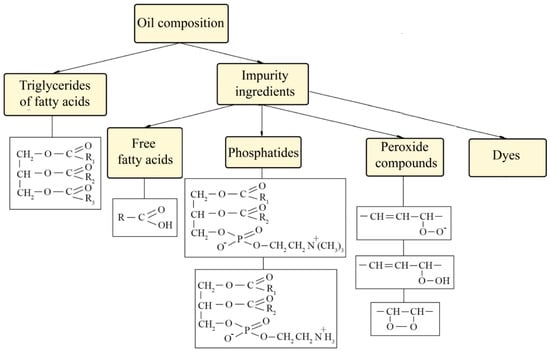
Figure 1.
The composition and main impurity ingredients of vegetable oils.
The ingredients can be artificially introduced into oil-containing media. Thus, the action of inorganic sorbents and organic additives, when they are jointly added into vegetable oils [23], often provides a high antioxidant effect. Depending on the required extraction rate of a particular impurity with polar or low-polar properties, the residence time of the contact between the solid composite material (s) and the liquid phase of the oil (l) can be variable. For example, to clarify sunflower oil, it may be necessary to activate natural aluminosilicate raw materials with hydrochloric acid (molarity = 3) for 2 h [14]. In some cases, it is recommended to vary the oil processing time up to 6 h to extract ≥50% of the components of the pigment complex, and the consumption of the sorption material should be selected depending on the process temperature (up to 448 K) [24]. For the purification of exotic oils that are rarely refined, the amount of sorbent can fluctuate in the range of 0.4–2.0% of the weight of the oil [25]. The influence of aluminosilicate materials on the process of extracting fatty acids (up to 37%) from oil-containing media is shown in [26].
The novelty of the proposed approaches consists in the creation of composite aluminosilicate materials using organic acids as modifying additives for natural mineral sorbents instead of hydrochloric acid [27], as well as sodium carbonate in scientifically-substantiated amounts. The created materials are proposed to be used to extract impure substances from vegetable oils that are rarely refined in world production and are of high value for medicinal chemistry (flaxseed, olive, mustard).
The practical value of research is associated with the possibility of the simultaneous sorption extraction of excess fatty acids and peroxides from vegetable oils, which, along with the whitening effect, makes it possible to increase their shelf life.
This work aims to obtain modified composite materials based on aluminosilicate raw materials by modifying them with solutions of organic acid (oxalic, succinic) and an alkaline agent (sodium carbonate), to ensure the redistribution of active centers on the surface, to study the physicochemical properties of the materials obtained, and to select the main parameters of the extraction of impurity ingredients of rarely refined oil-containing media.
2. Materials and Methods
The following materials were used in this study:
- Unrefined Linseed oil (OOO “LEN NN”, Nizhny Novgorod, Russia); Specification TU 9141-002-55854031-03);
- Unrefined olive oil (ABPSAU, Terrega, Spain);
- Unrefined mustard oil (OOO Chelyabinsk oil and fat plant, Chelyabinsk, Russia), corresponds to the Russian State Standard GOST 8807-94);
- Glacial acetic acid (chemically pure);
- Oxalic acid (pure);
- Succinic acid (pure);
- Ethyl alcohol (Russian State Standard GOST R 51652-2000);
- Chloroform (chemically pure);
- Diethyl ether (analytical grade);
- Phenolphthalein;
- Natural mineral sorbents—powders of blue montmorillonite-containing (Specification TU 9158-001-17033721-2014), green Fe (II)-containing (Specification TU 9158-001-17033721-2014) and pink Fe (III)-containing clays (Specification TU 9158- 003-47308774-00);
- Sodium thiosulfate (chemically pure);
- Potassium hydroxide (chemically pure);
- Potassium bromide (analytical grade).
X-ray diffraction patterns were registered using the D8 Advance diffractometer (Bruker, Leipzig, Germany) with CuKα-radiation (λ = 1.5406 Å) at 2Θ = 10–70 deg. Elemental analysis was performed using the CHNS-O Analyzer Flash EA 1112 Series (Thermo Finnigan Italia S.p.A., Rodano, Italy). Surface titration curves (pKa spectroscopy data) and histograms corresponding to the concentration (molar fraction qi) of active centers were plotted after processing the experimental data obtained from the IPL-311 Multitest (NPP SEMIKO, Russia) by the Ryazanov–Dudkin technique [28].
The surface microphotographs of the original and modified composites were obtained by scanning electron microscopy using VEGA 3 SBH (Tescan, Brno, Czech Republic) at a voltage of 5.0 kV. The device is equipped with a carbon spraying unit. The elemental analysis was carried out by the four-probe method. To assess the particle distribution by fraction, the Analysette 22 laser analyzer (Fritsch, Idar-Oberstein, Germany) was used. The infrared spectra in the range of 4000–400 cm−1 were recorded using the Avatar 360 FT-IR (Nicolet Instrument Corporation, Madison, WI, USA), where tableted samples were placed in a mixture with crystalline KBr.
2.1. Obtaining Composite Aluminosilicate Materials from Natural Mineral Raw Materials
To obtain acid-modified composite materials, acid (acetic, oxalic, amber) in the form of an aqueous 6% solution in mass ratio l–s = 1:1 was vaporized on the surface of natural mineral raw materials (powder blue, pink, and green clays) [27]. The clays were previously calcined for 3 h at 373–393 K, sieved with the release of particles with a size of 2–30 μm. The obtained mixture was dried at 293 K and 1 atm. To obtain composite materials modified by the acid-base method, sodium carbonate was added at the rate of 1:10, 15–18 wt% water, ground in a mortar, again dried to constant weight at 393–403 K, and ground to a powder state.
2.2. Determination of Dyes and Acidity of Vegetable Oils
The sorption effect of the developed composite aluminosilicate materials was tested on samples of unrefined linseed oil (acid number 1.9 mg KOH), mustard oil (acid number 2.9 mg KOH), and olive oil (acid number 3.4 mg KOH).
The experiments were carried out under normal conditions (293 K, 1 atm). In a glass flask containing 100 g of vegetable oil, 1 g of a natural sorbent or a developed composite aluminosilicate material was introduced. Stirring was carried out at an intensity of 1–2 s−1 for 5 h. Every hour, samples were taken, the solid phase was separated on the filter. To determine the total content of chlorophylls and carotenoids, oil was mixed with acetone in a ratio of 1:5, and the total content of chlorophylls and carotenoids was determined using the Shimadzu UV-1800 (Shimadzu, Kyoto, Japan) two-beam at λmax = 670 nm and λmax = 450 nm, respectively [29].
The absence of a solid phase in the vegetable oil after the adsorption of impurity chlorophylls and carotenoids was confirmed by atomic absorption spectrometry using the 210 VGP apparatus (Buck Scientific, Norwalk, CT, USA). The extraction rate of dyes from vegetable oils (α, %) was calculated according to the method described in [27]. Acid and peroxide numbers of oils before and after contact of the solid and liquid phases were determined according to the Russian State Standard GOST 31933-2012 “Vegetable oils. Methods for determination of acid number” and the Russian State Standard GOST ISO 3960-2013Р “Animal and vegetable fats and oils. Determination of the peroxide number. Iodometric (visual) endpoint determination”.
Chromatographic studies were carried out in accordance with the Russian State Standard GOST 30418-96 “Vegetable oils. Method for determination of fatty acid composition of samples of unrefined olive oil and oil treated with blue clay”. The samples of unrefined olive oil and oil treated with blue clay were studied for 1 h with the concentration of clay in the liquid phase of 10 g·kg−1. The Kristall Lux 400 (Chromatec, Yoshkar-Ola, Russia) device and a solution of sodium ethylate in ethanol with a concentration of 2 mol dm−3 were used.
3. Results
3.1. Modification of the Surface of Natural Mineral Raw Materials and Production of Composite Materials for the Sorption of Vegetable Oil Impurities
The detected intense lines at pKa near 7.0 (Figure 2a) emphasizes the presence of surface neutral centers in blue montmorillonite-containing clay [21], which simultaneously function as donors and acceptors. The natural sample also has Brønsted centers (pKa working area of 5.0–6.0). The possibility of the presence of Brønsted surface centers, which have pKa from 5.0 to 6.0, in such aluminosilicates is shown in [21] and the works of M.A. Ryazanov and B.N. Dudkin. They are formed with the help of hydroxyl groups at the vertices of montmorillonite tetrahedra, prone to protonation.
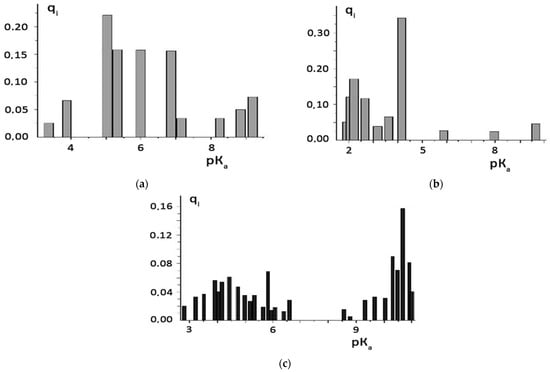
Figure 2.
Distribution of active sites on the surface of blue clay before (a) and after spraying with acetic acid (b) and acid-base treatment (c).
As a result of spraying acetic acid solution on the surface of the raw material (dissociation constant K = 1.8 × 10−5), only a weak line remains on the histogram at pKa = 5.7–6.1 instead of three clear lines in the “neutral” region (Figure 2b). In this case, the total concentration of acid sites increases sharply (Figure 2b, region 1.8–4.2) as a consequence of the binding of carbonyl oxygen according to the reaction, Figure 3 [30]:
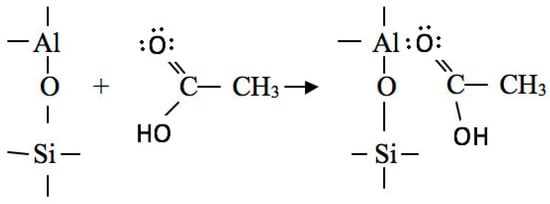
Figure 3.
The reaction of binding of carbonyl oxygen.
The introduction of sodium carbonate into the system after treatment with acetic acid promotes the appearance in the pKa spectrum of a cascade of lines in the range 8.7–11.2 (Figure 2c). This indicates the formation of new basic Brønsted centers (the bond between oxygen and hydrogen atoms in the hydroxyl group is strengthened). At the same time, the resulting hybrid material is characterized by a high concentration of acid sites on the surface (scattering of lines at рКа from 2.8 to 5.3). When the metal electron takes its place on the oxygen orbital, the acid Lewis centers make contact with the oxygen atom of the alkaline, modifying the additive according to reactions, Figure 4 [30]:
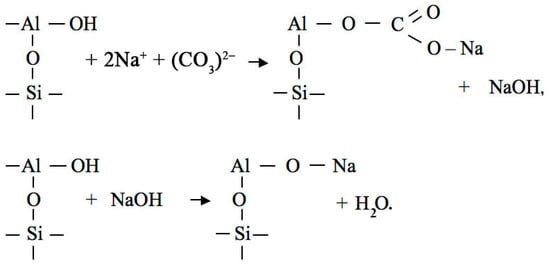
Figure 4.
The reaction occurring after sodium carbonate introduction into the system.
Since both Brønsted and Lewis centers are present on the surface of the resulting modified material, this should have an effect on increasing its sorption capacity both to free fatty acids contained in vegetable oils in various amounts and to other impurities in triglyceride solutions (for example, compounds of heavy metals). The question arises about the influence of the strength of an organic acid on the destruction of the crystalline skeleton of polymineral raw materials.
Montmorillonite in its natural form and modified state [31] is of great interest to researchers as a sorption-active material. The scanning electron microscopy studies of the surface of blue clay, consisting mainly of SiO2 compounds and montmorillonite, showed that particles of 1–2 µm in size predominate in natural raw materials (Figure 5a).
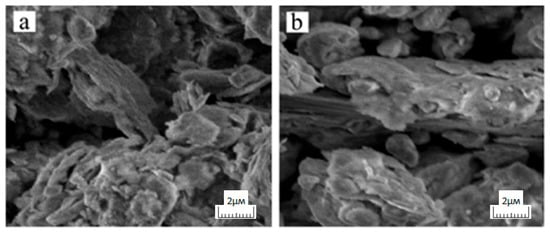
Figure 5.
Surface of blue clay (a) and composite aluminosilicate material after acid modification by oxalic acid (b) at 5000× magnification.
Spraying on the surface of a 6% solution of dibasic oxalic acid (dissociation constants К1 = 5.6 × 10−2, К2 = 5.4 × 10−5) resulted in obtaining a more crystallized meso- and macroporous sorbent with increased surface cleanliness and porosity, in comparison with the initial sample (Figure 5b). The scattering of pores in the resulting material (100 nm–2 μm) is also wider than that of natural blue clay powder. It can be assumed that impurity molecules of esters of fatty acids (waxes) or cyclic compounds of vegetable oil, in view of there being a great variety in diameters, will be more actively sorbed on such a surface, as described in [31,32].
The chemical composition of blue clay (natural raw material) consists mainly of silicon and aluminum oxides. The impurity compounds are oxidized forms of iron, magnesium, and potassium, as well as tin and titanium dioxide (rutile form) (Table 1).

Table 1.
Concentration of elements on the surface of a blue clay sample and composite aluminosilicate materials.
A solution of relatively strong oxalic acid affects the deep impurity layers of blue clay; part of the alkaline cations is carried to the surface. The Мg2+ content changes are especially noticeable (see Table 1), and the flaky saponite particles (1–3 μm) with the inclusion of magnesium are seen more clearly in the scanning electron microscope (Figure 5b). The number of flaky impurity clots, which are a distinctive feature of the surface of natural blue clay (Figure 5a), also decreases after exposure to the specified acid (Figure 5b). Additionally, when decoding the signals of the diffraction patterns of natural blue clay that were treated with oxalic acid, we revealed an increase in the signal intensity at 2Θ = 26.64 deg. (quartz) and, on the contrary, the disappearance of 2Θ = 17.77 deg and a slight decrease of 2Θ = 12.4 deg reflections attributed to cristobalite and kaolinite, respectively.
The infrared spectrum of acid-modified composite material (Figure 6), showed an increase in the band at 1740–1580 cm−1 and the appearance of a peak at 1649 cm−1 (Figure 6, curve 2). The result should be interpreted as the contact of carboxyl groups with the surface of blue clay and the activation in the system of polymer hydrate forms caused by the addition of a solution. The intensity of stretching vibrations of the silicon–oxygen Si–O bond in the region of 1020 cm−1 (Figure 6, curves 1 and 2) remains unchanged. This emphasizes the stability of the silicon–oxygen framework when exposed to an organic acid on the surface. Elemental analysis data (Si, 15.0 and 13.7%, Table 1) confirm the hypothesis [25] about the absence of significant destruction of the mineral framework when a sufficiently strong oxalic acid is sprayed onto the surface. In this case, the content of aluminum compounds in contact by reaction (1) increases in the system from 6.5 to 9.0% (Table 1).
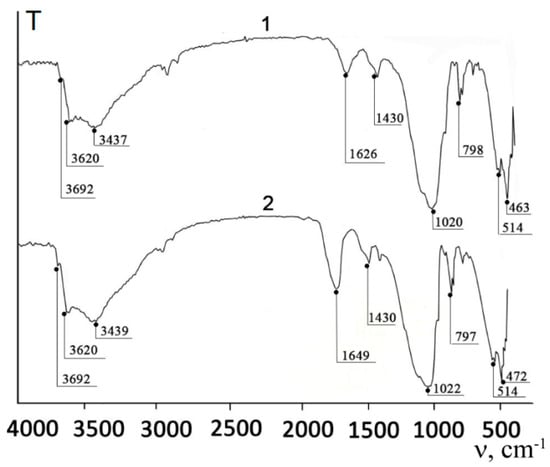
Figure 6.
Infrared spectra of samples of blue clay (1) and material after treatment with oxalic acid (2).
As a result of acid-base treatment of the surface, oxidized forms of sodium (1.2%, Table 1) obtained during the reaction (3) were additionally detected in its composition. This is expressed by the presence of light, newly-formed structures on microphotographs. The resulting X-ray amorphous material, in comparison with natural raw materials, which includes individual globules and agglomerates up to 50 μm in size (Figure 7a), is looser, more porous, and has significant differences in the size and shape of particles (Figure 7b). In addition to round quartz particles (≤1 µm), cristobalite (≤3 µm), and montmorillonite, acicular rocks, and fibrous structures (wollastonite-like) were also found on the surface (Figure 7b), which should affect the sorption properties.
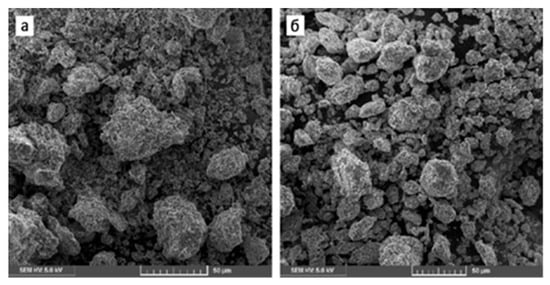
Figure 7.
Surface of blue clay (a) and composite aluminosilicate material obtained as a result of treatment with oxalic acid and sodium carbonate (b) at 400× magnification.
Similar changes in the state of the surface after modification using the considered compounds are also observed for the samples of green and pink clays.
3.2. Results of Sorption Extraction of Vegetable Oil Impurity Substances
It was found that even at a low consumption of pink Fe (III)-containing clay (3–5 g·kg−1), which includes, in addition to montmorillonite and quartz, a significant (up to 30%) amount of impurities of saponite, kaolinite, and goethite, the extraction rate of free fatty acids (FFA) from mustard oil is 27%. Modified pink Fe (III)-containing clay is superior to other materials (up to 37%) with respect to the extraction of peroxide compounds of oils (consumption of 10 g·kg−1). The study of the dynamics of sorption of fatty acids of flaxseed oil during its processing with composite materials shows that the modification of aluminosilicate raw materials with solutions of dibasic succinic (К1 = 7.4 × 10−5, К2 = 4.5 × 10−6) and oxalic (stronger) acids generally, but insignificantly (by 20–30%), increases its affinity for adsorbate molecules (Figure 8a,c, curves 1 and 3), and in some cases it is not required at all (Figure 8b, curves 1–3).
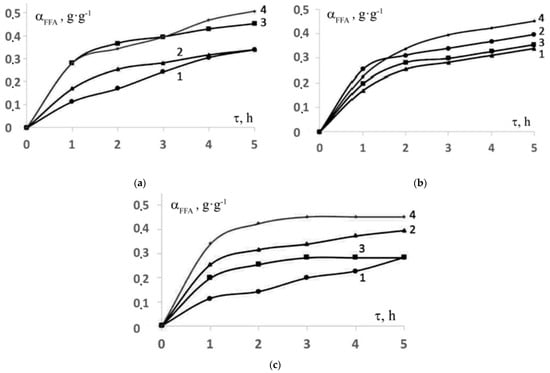
Figure 8.
Extraction of free fatty acids of linseed oil during processing with natural (1, a–c) clays and composites with the inclusion of oxalic (2), succinic (3) acids, oxalic acid and Na2CO3 (4); (a)—blue; (b)—pink; (c)—green.
The action of acid-base modification of raw materials is characterized by a more striking effect of the extraction of fatty acids compared to natural clays (Figure 8a–c, curves 1 and 4).
The sorption process has the highest activity in the first two hours (stage I, up to 90% of impurities are extracted). In the next 3–4 h (stage II), the limiting value of αFFE is reached, not exceeding 0.5 g·g−1. Another important characteristic is the content of peroxide compounds in the liquid phase. The dynamics of changes in the peroxide number was monitored for 90 days of storage of the unrefined vegetable oils in a dark place at 293 K. In the medium of mustard oil, the presence of antioxidant properties in all samples of natural mineral raw materials was revealed, while pink Fe (III)-containing clay slows down the oxidation process most qualitatively. This result is in line with the lower (in comparison with other aluminosilicate raw materials) content of quartz additive in pink clay and the presence of a cascade of intense bands in the pK spectrum near 8.0. In this case, a certain influence is apparently also exerted by the specificity of the granulometric composition of pink clay (the content of kaolinite is increased; 45% of the particles have a size of no more than 2.5 μm). Thus, the use of natural blue clay, including partial formations up to 50 µm (Figure 7a), when introduced into mustard oil to stabilize its properties, is less effective, even in comparison with green clay.
The chromatographic analysis of olive oil esters shows that in an unrefined medium, the share of saturated acids is only 19.1%. After processing this oil for 1 h with blue clay, it was found that at stage I of the adsorption process, the clay material most actively absorbs oleic С18:1 and linoleic С18:2 unsaturated fatty acids. These acids are the main components of the oil-containing medium (Table 2).

Table 2.
Calculated data on the concentration of fatty acids in olive oil before/after treatment with blue montmorillonite clay and adsorption.
The pink Fe (III)-containing clay after 1 h of contact with olive oil under normal conditions absorbs 4 × 10−4 mol·L−1 of palmitoleic acid, 1.9 × 10−2 mol·L−1 of oleic acid, 3.7 × 10−3 mol·L−1 of linoleic acid, and 1.6 × 10−4 mol·L−1 of linolenic acid. The activity of this mineral sorbent towards total fatty acids of olive oil, in comparison with blue clay, is lower by an average of 27%.
When flaxseed oil is purified from peroxide compounds, a satisfactory result is achieved after acid modification of blue montmorillonite-containing clay. However, the best results were again obtained using pink Fe (III)-containing clay (50%) subjected to acid-base modification (Table 3).

Table 3.
Influence of natural and composite aluminosilicate materials on the peroxide number of flaxseed oil.
The absorption spectra of linseed oil revealed the presence of dyes. These are unsaturated hydrocarbons (lycopene, maximum at 475 nm), flavoxanthins C40H56O3 (λ = 422 nm), and their mixtures with luteoxanthins (maximum at 447 nm) (Figure 9). The oxidized hydrocarbon forms, which include oxygen atoms and are called xanthophylls, are valuable biological compounds and, together with lycopene, form the total carotenoids of vegetable oils.
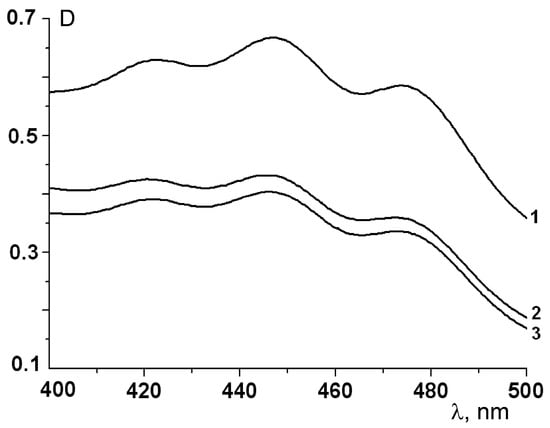
Figure 9.
Linseed oil absorption before (1) and after exposure for 1 h (2) and 5 h (3) with acid-modified material of blue clay (2, 3).
The high effect of the release of carotenoids at their initial concentration C0 = 26 mg·kg−1 is provided by natural blue clay (Table 4), not processed into a composite sorbent. In the presence of powders of pink Fe (III)-containing and green Fe (II)-containing clays, this effect is much less pronounced (by 21–31%). Moreover, an active absorber of linseed oil carotenoids is a composite material obtained by spraying solutions of succinic and oxalic acids on the surface of natural green clay (Table 4), including, according to X-ray phase analysis, in addition to quartz and montmorillonite, impurity α-cristobalite, scolecite, brewsterite, and kaolinite, and having a plurality of pores with a diameter of about 10 μm.

Table 4.
Influence of composite aluminosilicate materials on the extraction rate of carotenoids from linseed oil.
The effect of the action of these acid solutions on the sorption capacity of this material towards the total carotenoids is numerically comparable and is estimated at 1.1 mg·g−1.
The result of extracting the acid solutions after 3 h of mixing flaxseed oil (l) and sorbent (s) practically does not require a longer contact of the phases, a choice between organic acids of different strengths for modification and, in the case of blue clay, the actual processing of the raw material. It was also revealed that the presence of depleted intermediate cationic layers (impurity hydromuscovite) in the material, despite the presence of an active fraction of montmorillonite in blue clay, largely neutralizes the bleaching effect on vegetable oils (the color number does not change). Another important factor determining the weak extraction of dying (pigment) substances from oils is the moderate temperature (293 K) of the liquid phase processing. However, it should be remembered that the heat exposure on oxalic acid increases the risk of carbon monoxide emission and adversely affects the environmental friendliness of the adopted technical solutions. Similar dependences were also obtained when monitoring the peroxide value of flaxseed oil.
At the same time, the experimental data show that the extraction rate of common carotenoids from olive oil using natural mineral sorbents and acid-modified clay materials is the following:
- 50% for blue clay; no effect for blue clay and succinic acid modifier; 64% for blue clay and oxalic acid modifier;
- 38% for pink Fe (III)-containing clay; no effect for pink clay and succinic acid modifier; 45% for pink clay and oxalic acid modifier.
When processing mustard oil with natural and modified composite materials, the spraying of 6% succinic acid solutions on the surface of pink Fe (III)-containing clay increases the limiting sorption of carotenoids from the specified oil by almost 50%, and when processing this material with a stronger oxalic acid, the doubling of the positive effect is observed.
The extraction rate of chlorophylls from linseed and olive oil using the developed composite materials is at the level of 70–80%. This indicator, in comparison with the effect of natural mineral sorbents on oils, changed weakly. The adsorption process, by analogy with impurity fatty acids, actively proceeds for 1 h. Then, after 5–6 h, a state of equilibrium is reached in the l–s system.
4. Conclusions
New composite aluminosilicate materials were obtained based on the processing of powders of blue montmorillonite-containing, pink Fe (III)-containing, and green Fe (II)-containing clays. These new materials are intended for the efficient extraction of unsaturated fatty acids, peroxide compounds, total carotenoids, and chlorophylls contained in flaxseed, olive, and mustard oils.
It was shown that the modification of the surface of aluminosilicate raw materials with solutions of acetic, oxalic, and succinic acids leads to the dilution of impurity minerals (kaolinite, saponite, etc.). In this case, the removal of cations of magnesium, aluminum, and iron to the surface occurs and the porosity of materials increases. Subsequent treatment with sodium carbonate in a ratio of 1:10 ensures the formation of new basic centers with the inclusion of sodium on the organic–inorganic surface. Their effect is expressed in the increased adsorption of fatty acids from oils not refined in production by up to 0.5 g·g−1 and a 30–50% decrease in the content of peroxide compounds in them.
It was revealed that the developed composite materials allow the extraction of 64–80% of total carotenoids and chlorophylls from linseed and olive oils that have not been subjected to industrial purification.
Author Contributions
Conceptualization, A.A.I.; formal analysis, L.R.M.; investigation, A.A.I., R.S.N. and L.R.M.; methodology, P.B.R.; project administration, P.B.R. and N.A.P.; visualization, R.S.N. and S.B.I.; writing—original draft, P.B.R., N.A.P. and S.B.I. All authors have read and agreed to the published version of the manuscript.
Funding
This research was conducted by Peter the Great St. Petersburg Polytechnic University and supported under the strategic academic leadership program “Priority 2030” of the Russian Federation (Agreement 075-15-2021-1333 dated 30 September 2021).
Institutional Review Board Statement
Not applicable.
Informed Consent Statement
Not applicable.
Conflicts of Interest
The authors declare no conflict of interest.
References
- Hlihor, R.M.; Gavrilescu, M. Removal of some environmentally relevant heavy metals using low-cost natural sorbents. Environ. Eng. Manag. J. 2009, 8, 353–372. [Google Scholar] [CrossRef]
- Gordin, N.E.; Prokofiev, V.Y. Low-Modulus Zeolites: Structure. Properties. Synthesis; Krasand: Moscow, Russia, 2017. [Google Scholar]
- Razgovorov, P.B.; Nagornov, R.S.; Razgovorova, M.P. Utilization of blue clay for separation of impurities from linseed oil. Izv. Vyss. Uchebnykh Zaved. Khimiya Khimicheskaya Tekhnologiya 2014, 57, 72–75. [Google Scholar]
- Prokofiev, V.Y.; Razgovorov, P.B.; Gordina, N.E. The adsorption of undesirable impurities from sunflower oil on the granulated sorbents based on kaolin clay. Int. J. Food Eng. 2014, 10, 713–720. [Google Scholar] [CrossRef]
- Mannu, A.; Vlahopoulou, G.; Urgeghe, P.; Ferro, M.; Del Caro, A.; Taras, A.; Garroni, S.; Rourke, J.P.; Cabizza, R.; Petretto, G.L. Variation of the chemical composition of waste cooking oils upon bentonite filtration. Resources 2019, 8, 108. [Google Scholar] [CrossRef]
- Razgovorov, P.B.; Nagornov, R.S.; Razgovorova, M.P.; Grechin, O.V. Regulation of aluminosilicate materials acid-base properties for action on purification degree of olive oil. Izv. Vyss. Uchebnykh Zaved. Khimiya Khimicheskaya Tekhnologiya 2015, 58, 58–63. [Google Scholar]
- Arutyunyan, N.S. Refining Oils and Fats; GIORD: Saint Petersburg, Russia, 2004. [Google Scholar]
- Meunier, A. Clays; Springer: Berlin/Heidelberg, Germany, 2005; ISBN 978-3-540-27141-3. [Google Scholar]
- Breen, C. Acid-activated organoclays: Preparation, characterization and catalytic activity of polycation-treated bentonites. Appl. Clay Sci. 1998, 12, 479–494. [Google Scholar] [CrossRef]
- Uriev, N.B. Physicochemical dynamics of dispersed systems. Usp. Khim. 2004, 73, 39–62. [Google Scholar] [CrossRef]
- Pen, R.Z. Rheological properties of coating suspensions. Chem. Veg. Raw Mater. 2004, 4, 11–15. [Google Scholar]
- Simić, V.; Životić, D.; Miladinović, Z. Towards better valorisation of industrial minerals and rocks in Serbia—Case study of industrial clays. Resources 2021, 10, 63. [Google Scholar] [CrossRef]
- Khan, A. Bleaching of Vegetable Oil using Organic Acid Activated Fuller’s Earth (Bentonite Clay). Glob. J. Res. Eng. 2015, 15, 1–5. [Google Scholar]
- Hechi, E.; Amor, O.B.; Srasra, E.; Zargouni, F. Physico-chemical characterization of acid-activated clay: Its industrial application in the clarification of vegetable oils. Surf. Eng. Appl. Electrochem. 2009, 45, 140–144. [Google Scholar] [CrossRef]
- Mukasa-Tebandeke, I.Z.; Ssebuwufu, P.J.M.; Nyanzi, S.A.; Nyakairu, G.W.; Ntale, M.; Lugolobi, F.; Andreas, S. Adsorption Behavior of Acid-Leached Clays in Bleaching of Oil. Am. J. Anal. Chem. 2015, 6, 495–512. [Google Scholar] [CrossRef][Green Version]
- Ayari, F.; Srasra, E.; Trabelsi-Ayadi, M. Effect of exchangeable cations on the physicochemical properties of smectite. Surf. Eng. Appl. Electrochem. 2007, 43, 369–378. [Google Scholar] [CrossRef]
- Teng, M.Y.; Lin, S.H. Removal of basic dye from water onto pristine and HCl-activated montmorillonite in fixed beds. Desalination 2006, 194, 156–165. [Google Scholar] [CrossRef]
- Patel, M.A.; Kar, A.S.; Kumar, S.; Tomar, B.S. Effect of phosphate on sorption of Eu(III) by montmorillonite. J. Radioanal. Nucl. Chem. 2017, 313, 537–545. [Google Scholar] [CrossRef]
- Zhou, Q.; Pan, G.; Shen, W. Enhanced sorption of perfluorooctane sulfonate and Cr(VI) on organo montmorillonite: Influence of solution pH and uptake mechanism. Adsorption 2013, 19, 709–715. [Google Scholar] [CrossRef]
- Gunstone, F.D. Production and Trade of Vegetable Oils. In Vegetable Oils in Food Technology: Composition, Properties and Uses, 2nd ed.; Blackwell Publishing Ltd.: Hoboken, NJ, USA, 2011; pp. 1–24. [Google Scholar] [CrossRef]
- Nagornov, R.S. Processing of Natural Aluminosilicate Materials into Sorbents for Purification of Triglycerides of Fatty Acids. Ph.D. Thesis, Ivanovo State University of Chemistry and Technology, Ivanovo, Russia, 2018. [Google Scholar]
- Creencia, E.C.; Nillama, J.A.P.; Librando, I.L. Microwave-assisted extraction and physicochemical evaluation of oil from Hevea brasiliensis seeds. Resources 2018, 7, 28. [Google Scholar] [CrossRef]
- Di Mattia, C.; Paradiso, V.M.; Andrich, L.; Giarnetti, M.; Caponio, F.; Pittia, P. Effect of Olive Oil Phenolic Compounds and Maltodextrins on the Physical Properties and Oxidative Stability of Olive Oil O/W Emulsions. Food Biophys. 2014, 9, 396–405. [Google Scholar] [CrossRef]
- Chakroun, S.; Herchi, M.; Mechti, W.; Gaied, M.E. Acid activation of upper Eocene Ca-bentonite for soybean oil clarification. Environ. Sci. Pollut. Res. 2017, 24, 22557–22569. [Google Scholar] [CrossRef]
- Yoon, S.H. Optimization of the refining process and oxidative stability of chufa (Cyperus esculentus L.) oil for edible purposes. Food Sci. Biotechnol. 2016, 25, 85–90. [Google Scholar] [CrossRef]
- Su, H.; Wang, X.; Kim, Y.G.; Kim, S.B.; Seo, Y.G.; Kim, J.S.; Kim, C.J. Optimization of decoloring conditions of crude fatty acids recovered from crude glycerol by acid-activated clay using response surface method. Korean J. Chem. Eng. 2014, 31, 2070–2076. [Google Scholar] [CrossRef]
- Vlasova, E.A.; Valueva, K.A.; Solomkina, Y.S.; Razgovorov, P.B. Application of Natural Clays for Purification of Rapeseed Oil from Colorant. Russ. J. Appl. Chem. 2020, 93, 1710–1714. [Google Scholar] [CrossRef]
- Ryazanov, M.A.; Dudkin, B.N. Study of the acid-base properties of g-Al2O3 by pK-spectroscopy. Colloid J. 2003, 65, 831–836. [Google Scholar] [CrossRef]
- Ivakhnov, A.D.; Skrabets, T.E.; Bogolitsyn, K.G. Supercritical fluid extraction of chlorophylls and carotenoids from Laminaria digitata. Chem. Veg. Raw Mater. 2014, 4, 177. [Google Scholar]
- Prokofiev, V.Y.; Razgovorov, P.B. Physicochemical processes occurring when kaolin clays are added to vegetable oils. Chem. Veg. Raw Mater. 2010, 2, 159–164. [Google Scholar]
- Razgovorov, P.B.; Prokofiev, V.Y.; Razgovorova, M.P. Study of the process of crystal formation of waxes in vegetable oils with the introduction of seed mineral additives. Chem. Veg. Raw Mater. 2013, 2, 207–212. [Google Scholar]
- Aladedunye, F.A.; Przybylski, R. Frying performance of canola oil triacylglycerides as affected by vegetable oils minor components. JAOCS J. Am. Oil Chem. Soc. 2012, 89, 41–53. [Google Scholar] [CrossRef]
Publisher’s Note: MDPI stays neutral with regard to jurisdictional claims in published maps and institutional affiliations. |
© 2022 by the authors. Licensee MDPI, Basel, Switzerland. This article is an open access article distributed under the terms and conditions of the Creative Commons Attribution (CC BY) license (https://creativecommons.org/licenses/by/4.0/).